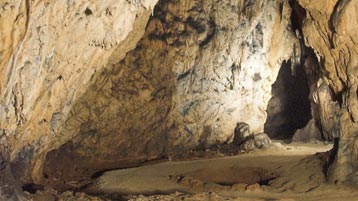
|
Our country is a speleological El Dorado. Not many countries in the world have so much surface covered in karst. Over fifty per cent of Croatian territory, even seventy per cent if we include the undersea surface area, is made of limestone. Limestone easily dissolves in water. Interaction of water and limestone creates a unique and specific relief with a large number of karst forms. In our country, karst stretches from Istria, over Croatian Littoral, Gorski Kotar, Kordun, Lika and Dalmatia including islands, all through the border with Monte Negro. It is part of Dinaric Kras, called after the representative mountain of the area, the impressive Dinara Mountain, located at the border of Croatia and Bosnia and Herzegovina, a typical, limestone dominated mountain. Dinaric Kras extends from Soča, along the Adriatic Sea, all through Albania. |
Characteristic karst forms are: karst fields, karst valleys, karrens, subterranean rivers, karst springs, lakes – the so-called “eyes of the mountain”, abysses (estavels)... Karst has specific hydrology. Rivers and streams in limestone carve out deep beds that often end up plunging underground to continue with their flow through subterranean ways. This is one of the ways how underground forms of karst are formed, in equally interesting and specific forms as the surface ones.
The research of underground phenomena is what speleology – the science of natural underground cavities - does. In Croatia, there are over 8,000 thousand speleological sites. Approximately less than half of them have been explored so far. A large portion of the contribution in revealing the secrets of natural underground is provided by scientists from different fields, mainly geologists, hydrologists, biospeleologists, metheorologists, especially palaeontologists and archaeologists, given the fact that caves in the recent geological history served as dwellings of different animals, Neanderthals, even the modern man. Most often, the evidence was discovered in the deposits at cave entrances or deeper inside, in the tunnels. Croatia knows a large number of speleological sites marked by abundance of cave jewels, endemic species of cave fauna (such as olms), and valuable
paleontological and archaeological findings. A small number of caves and pits has been turned into tourist sites. Among the well-known caves, the Upper andLower Cerovac Caves near Gračac in the region of Lika became tourist sites. These also include Vrelo Cave near Fužine, and Lokvarka near Lokve in Gorski Kotar, Vrlovka near Ozalj, Grgas Cave near Samobor, Veternica on the slopes of Zagrebačka Gora, Vranjača near Split, Biserujka on the island of Krk and the only pit that has been turned into a tourist site – Baredine Pit near Poreč. Apart from caves open to tourists, there is a large number of semi-tourist caves, and some of them were cleared more than a century ago. Such notable caves include Samograd Cave in Perušić and Caves of Barać in Nova Kršlja near Rakovica in the Kordun region.
Caves of Barać are located some six kilometres to the east of Rakovica (highway Zagreb-Split), just over half a kilometre to the west from the centre of the village of Nova Kršlja. Entrances to all three caves from the north are called Baraćeve Brine. At the bottom of Brine, between the entrances to the caves, is Baraćevac spring, which, together with two smaller springs (without name) form Kršlja stream that merges with the Suvaja stream some twenty meters downstream. Kršlja flows several kilometres through the field, and at its eastern part, through a series of pits, enters the Varićak Cave, where it accounts for the greatest amount of water mass in its channels. Caves of Barać were once known as Radaković Caves. The last name Barać no longer exists in this region – this is a toponym from the times before or during Turkish invasions. According to the local legend, the caves were named after someone named Barać who defeated the furious Turkish giant in the battlefield and earned himself such honour. We know that there are three caves. Some call them Large and Small, Upper and Lower, and the third one simply – the Third, which allegedly has nothing to do with the two former ones. After rediscovering the entrance and position, along with some new channels, we called the third one – the New Barać Cave. |